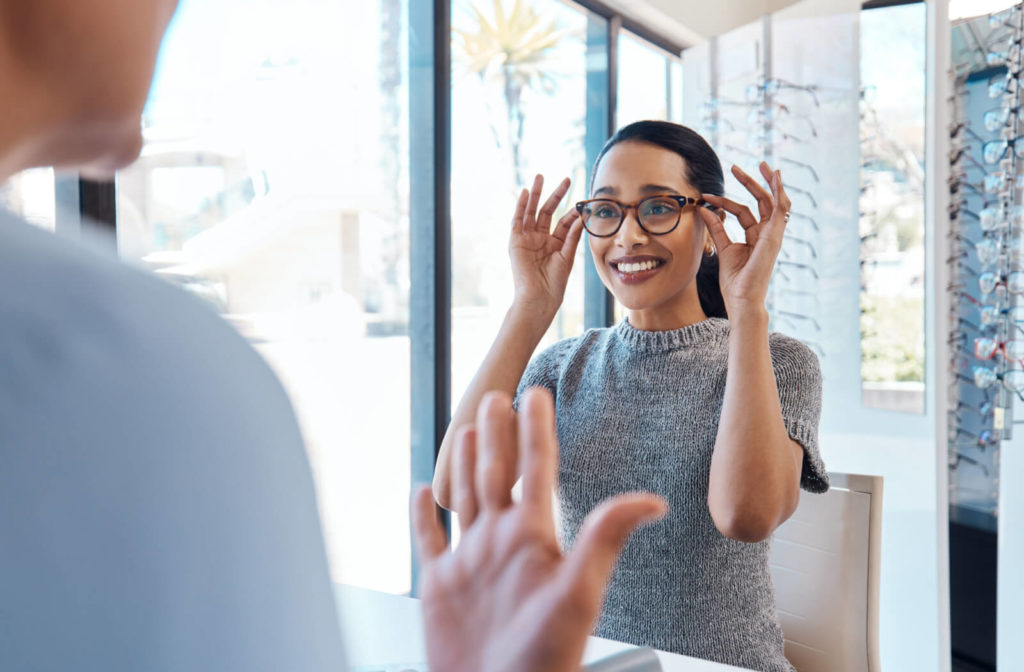A single-vision prescription lens is a common type of lens used to correct nearsightedness, but bifocal or progressive lenses may also be beneficial. There isn’t a “best” way to correct myopia (nearsightedness) because it ultimately depends on the severity of the refractive error, a person’s age, and their vision needs. For example, contact lenses or laser eye surgery could be great ways of correcting nearsightedness for some people.
A comprehensive eye exam with your eye doctor is a great place to start when deciding which route you want to choose for correcting nearsightedness. Your doctor can take your vision needs and overall eye health into account when recommending myopia correction methods.
What Are Single-Vision Lenses?
A single-vision lens for eyeglasses is a common way of correcting myopia. This type of lens is sufficient for improving most people’s distance vision and is designed with just a single prescription for adjusting vision at a specific distance.
Older adults who are affected by two different refractive errors, such as myopia and presbyopia, may benefit from bifocal or progressive lenses that can correct near and distant vision at the same time with multiple prescriptions in a single lens.
Other Myopia Correction & Control Methods
Myopia cannot be reversed, but there are several methods for correcting nearsightedness to provide clear distance vision. There are also myopia control methods that can help slow the refractive error’s progression in children or youth and help prevent high myopia, which can contribute to other eye conditions.
Contact Lenses
Contact lenses may be an option for many people of different ages. Single-vision contact lenses can help you see clearly, but there are also multifocal contact lenses available that have shown promising results in slowing myopia progression in children as young as 7.
Ortho-K
Ortho-k, short for orthokeratology, is a method used to control myopia that involves wearing specially designed contact lenses at night. Ortho-k lenses can gently reshape the curvature of your eye while you sleep to help you see clearly during the day without glasses or contacts.
Ortho-k lenses can also slow the progression of myopia for kids. They’re designed to be effective and safe—and they can also be a great option for adults who just want to see clearly during the day without glasses or contacts.
Atropine Eye Drops
Atropine eye drops are often used during eye exams to dilate eyes, and low-dose atropine has also shown promising results in helping slow myopia progression for kids. These drops work by blocking the muscarinic receptors in the eye, which control how the eye changes focus.
There is some debate on the most effective dosage of atropine eye drops, but concentrations from 0.01% to 0.05% have shown good effectiveness with minimal side effects.
Laser Eye Surgery
Laser eye surgery is less of a myopia control method and more of a long-term correction method. Not everyone is a candidate for refractive surgery, but it’s worth discussing your surgical options with your eye doctor if you’re an adult who doesn’t want to wear glasses or contacts.
How Do You Know You Have Nearsightedness?
Nearsightedness, also known as myopia, is a refractive error. This means that the eye doesn’t properly bend or refract light to focus it on the retina. People with myopia have trouble seeing things clearly at a distance but can typically see objects up close just fine—unless there are other refractive errors at work.
Myopia usually develops during childhood and can worsen during teenage years, often eventually stabilizing in early adulthood. Myopia affects approximately 1 in 3 people in the United States, and experts estimate that nearly half the world’s population will be affected by Myopia by 2050.
Causes of Myopia
The exact cause of myopia is not fully understood, but genetics and environmental factors may both play a role. Children may be more likely to develop myopia if one or both of their parents have myopia. Spending too much time focusing on close-up activities like reading, computer work, or phone use may also contribute to the development of myopia.
Symptoms of Myopia
One of the primary symptoms of nearsightedness is not being able to see distant objects, but some of the other symptoms of myopia can include:
- Headaches
- Eye strain
- Squinting
- Eye fatigue when doing tasks that require focus
Some of the signs of myopia in kids include:
- Difficulty paying attention or a short attention span
- Holding objects closer to their face
- Frequent eye rubbing
- Poor school performance
- Sitting too close to screens

Let’s Discuss How to Correct Nearsightedness for Your Needs
There isn’t one best approach to correcting or controlling myopia—the right lenses or methods for myopia correction can vary based on your needs. That’s something we can help you determine based on your particular eye health and lifestyle.
Call us at Total Vision La Mesa to book an eye exam for yourself or your child. One of our experienced optometrists can offer you personalized advice for choosing the right lenses and solutions to bring your vision more clarity.



